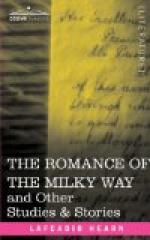[Footnote 6: Pueraria Thunbergiana.]
* * * * *
It was not until the time of the Tokugawa Sh[=o]gunate that the Tanabata festival became really a national holiday; and the popular custom of attaching tansaku of different colors to freshly-cut bamboos, in celebration of the occasion, dates only from the era of Bunser (1818). Previously the tanzaku had been made of a very costly quality of paper; and the old aristocratic ceremonies had been not less expensive than elaborate. But in the time of the Tokugawa Sh[=o]gunate a very cheap paper of various colors was manufactured; and the holiday ceremonies were suffered to assume an inexpensive form, in which even the poorest classes could indulge.
The popular customs relating to the festival differed according to locality. Those of Izumo—where all classes of society, samurai or common folk, celebrated the holiday in much the same way—used to be particularly interesting; and a brief account of them will suggest something of the happy aspects of life in feudal times. At the Hour of the Tiger, on the seventh night of the seventh month, everybody was up; and the work of washing the inkstones and writing-brushes was performed. Then, in the household garden, dew was collected upon yam-leaves. This dew was called Amanogawa no suzuki ("drops from the River of Heaven"); and it was used to make fresh ink for writing the poems which were to be suspended to bamboos planted in the garden. It was usual for friends to present each other with new inkstones at the time of the Tanabata festival; and if there were any new inkstones in the house, the fresh ink was prepared in these. Each member of the family then wrote poems. The adults composed verses, according to their ability, in praise of the Star-deities; and the children either wrote dictation or tried to improvise. Little folk too young to use the writing-brush without help had their small hands guided, by parent or elder sister or elder brother, so as to shape on a tanzaku the character of some single word or phrase relating to the festival,—such as “Amanogawa,” or “Tanabata,” or “Kasasagi no Hashi” (the Bridge of Magpies). In the garden were planted two freshly-cut bamboos, with branches and leaves entire,—a male bamboo (otoko-dak[’e]) and a female bamboo (onna-dak[’e]). They were set up about six feet apart, and to a cord extended between them were suspended paper-cuttings of five colors, and skeins of dyed thread of five colors. The paper-cuttings represented upper-robes,—kimono. To the leaves and branches of the bamboos were tied the tanzaku on which poems had been written by the members of the family. And upon a table, set between the bamboos, or immediately before them, were placed vessels containing various offerings to the Star-deities,—fruits, s[=o]men, rice-wine, and vegetables of different kinds, such as cucumbers and watermelons.




